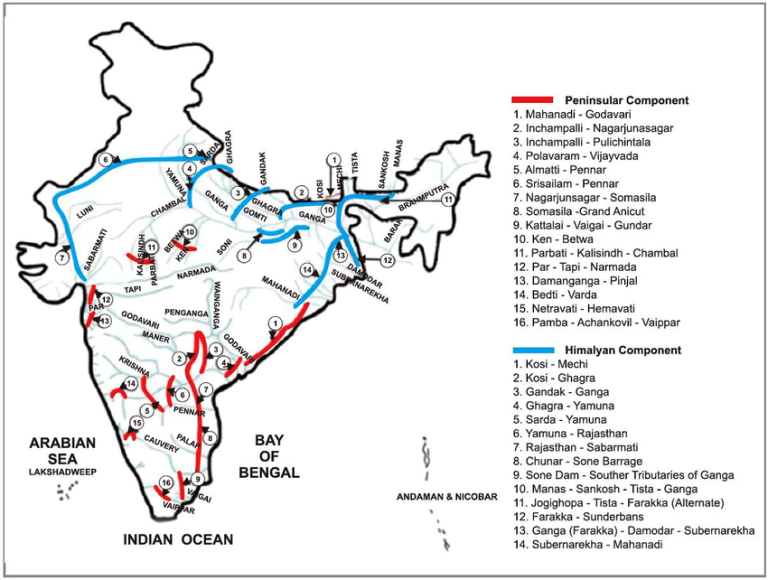Biodiversity & Environment
Ken-Betwa River Link Project
- 25 Jan 2023
- 5 min read
Prelims: Ken-Betwa River Link project, Panna Tiger Reserve, NGT, National Perspective Plan.
Mains: Ken-Betwa River Link project and associated issues.
Why in News?
Recently, the Ministry of Jal Shakti has chaired a meeting on Ken-Betwa Link Project (KBLP), stating that it is the “flagship” project of the national government and it “is crucial for the water security and socio-economic development of Bundelkhand region”.
- In December 2021, the Union Cabinet approved KBLP at a total cost of Rs 44,605 crore. In this project.
- The project has been delayed due to political and environmental issues.
What is the Ken-Betwa Link?
- About:
- The Ken-Betwa Link Project (KBLP) is the river interlinking project that aims to transfer surplus water from the Ken River in Madhya Pradesh (MP) to Betwa in Uttar Pradesh (UP) to irrigate the drought-prone Bundelkhand region.
- The region spread across the districts of two states mainly Jhansi, Banda, Lalitpur and Mahoba districts of UP and Tikamgarh, Panna and Chhatarpur districts of MP.
- The project involves building a 77-metre tall and a 2-km wide Dhaudhan dam (to be built within Panna Tiger Reserve) and a 230-km canal.
- Ken-Betwa is one of the 30 river interlinking projects conceived across the country.
- The Ken-Betwa Link Project (KBLP) is the river interlinking project that aims to transfer surplus water from the Ken River in Madhya Pradesh (MP) to Betwa in Uttar Pradesh (UP) to irrigate the drought-prone Bundelkhand region.
- Significance:
- It will not only accelerate the water conservation by construction of a multipurpose dam but will also produce 103 MW of hydropower and will supply drinking water to 62 lakh people.
What are the Concerns Related to the Project?
- Environmental:
- Because of certain environmental and wildlife conservation concerns like passing of the project though critical tiger habitat of panna tiger reserve, the project is stuck in for the approval from National Green Tribunal (NGT), and other higher authorities.
- Economic:
- There is a huge economic cost attached with the project implementation and maintenance, which has been rising due to delays in project implementation.
- Social:
- Reconstruction and rehabilitation caused due to displacement resulting from the implementation of the project will involve social cost as well.
- They are also concerned that the project will endanger the water security of Panna.
- Legal:
- There are also significant legal problems with the approval granted to the KBLP.
- Approval by the Standing Committee of the National Board for Wildlife to the Ken-Betwa link Project has not been proved to be necessary for the improvement and better management of the wildlife therein as provided in Section 35(6) of the Wildlife (Protection) Act, 1972.
What is the National Perspective Plan for Interlinking of Rivers?
- The National River Linking Project (NRLP) formally known as the National Perspective Plan, envisages the transfer of water from water ‘surplus’ basins where there is flooding, to water ‘deficit’ basins where there is drought/scarcity, through inter-basin water transfer projects.
- Under the National Perspective Plan (NPP), the National Water Development Agency (NWDA), has identified 30 links (16 under the Peninsular Component and 14 under the Himalayan Component) for the preparation of feasibility reports (FRs).
- The NPP for transferring water from water-surplus basins to water-deficit basins was prepared in August 1980.
What are Ken and Betwa Rivers?
- Ken and Betwa rivers originate in MP and are the tributaries of Yamuna.
- Ken meets with Yamuna in Banda district of UP and with Betwa in Hamirpur district of UP.
- Rajghat, Paricha and Matatila dams are over Betwa river.
- Ken River passes through Panna tiger reserve.
UPSC Civil Services Examination, Previous Year Question (PYQ)
Q. The interlinking of rivers can provide viable solutions to the multi-dimensional inter-related problems of droughts, floods, and interrupted navigation. Critically examine. (2020)






